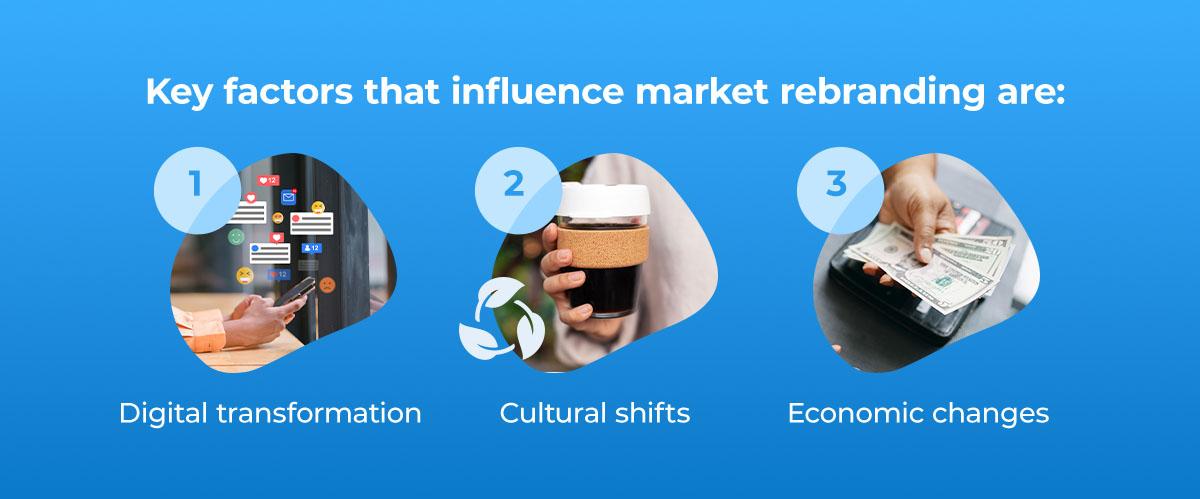In a world that moves at a mile a minute, businesses must adapt to survive. With brands like Blockbuster, Pan Am and Blackberry having fallen by the wayside, knowing when and how to rebrand can be the difference between reinvention and retreat.
Market rebranding is more than a new name, logo or product line — it’s a strategic response to shifting consumer expectations, technological advances and competitive pressures. Businesses that get it right set themselves up to thrive and maybe even dominate.
With so much at stake, you need to know why and how businesses should rebrand to prosper in a changing marketplace. Branded merchandise and corporate gifting can play a pivotal role in reinforcing your new brand identity at every touch point.
When Brand Evolution Is Not an Option
Rebranding is not an indication of failure. Many big names have executed successful rebrands, including Nike, Apple, eBay, Google and Facebook, now called Meta. Here are some of the main factors that made them rethink their branding strategy:
- Market forces: Consumer values are shifting toward sustainability, inclusivity, emotional branding and self-improvement. For example, Blue Ribbon Sports, a running shoe distributor, changed its name to Nike when it responded to market forces and began manufacturing its own shoes in 1978.
- Risks of standing still: Brands that fail to adapt can soon become outdated, losing market share and missing out on new opportunities. A pharmacist who invented a syrup sold as Brad’s Drink was declared bankrupt 30 years later. His assets were sold off, the syrup found its way into the hands of a candy manufacturer and the brand evolution of Pepsi-Cola began.
- Every touch point matters: Rebranding can be about signaling change to internal and external audiences. In 2015, Google rebranded its holding company as Alphabet to create a more focused structure for its diverse businesses and other ventures. The rebranding simplified the company’s structure, providing more autonomy for different business units and better transparency for investors.
Key Drivers of Rebranding for Your Market

It’s important to understand that a rebrand is not the same as a brand refresh. A brand refresh is a visual and tonal update. Rebranding is a transformation of identity and direction. It is an effective tool for market realignment. Key factors that influence market rebranding are:
- Digital transformation: The rise of e-commerce, social media and remote work has changed how brands engage with customers and employees.
- Cultural shifts: Movements around consumer preferences for sustainability, diversity and wellness are influencing brand values and messaging.
- Economic changes: Fluctuations in consumer spending and global supply chains demand more agility and responsiveness from brands.
6 Steps to a Successful Rebrand
A successful rebranding is the result of careful planning, clear communication and a thoughtful rollout that engages every stakeholder. Following a structured approach means your rebrand will resonate inside and outside your organization. Here’s how to navigate each step.
Step 1: Decide Purpose and Direction
A rebrand without a strong, strategic vision and fundamental purpose for driving the new direction can quickly lose its way. Fully understand the need for rebranding — a legacy brand that needs revitalization, one of many brands in a crowded category or a brand going through a crisis. Define customer perceptions of your brand, what you’d like your brand to represent and what you want your brand to achieve.
Step 2: Research Your Market
Gather insights from customers, employees and industry trends to inform your new brand direction. Leverage current data and consider focus groups and interviews. Use open-ended questions to collect critical information about perceptions and brand experiences.
Step 3: Create a Branding Strategy Statement
A rebrand pulls in people and opinions from many areas of your business. Create a branding strategy statement to function as a guideline through the rebranding process. Ideas can spin off into several new directions. Your branding statement keeps everyone on the same page.
Step 4: Refresh Visual Identity and Messaging
Update your logo, color palette and brand voice to reflect your new positioning. Ensure consistency across digital platforms, physical spaces and branded merchandise and gifts. Keep stakeholders informed with clear, honest updates. Use merchandise as a tool to reinforce key messages.
Step 5: Begin Your Rollout Strategy
Plan a phased soft and hard launch, starting with internal audiences and expanding to clients, partners and the public.
Step 6: Measure Impact
Track engagement, feedback and business outcomes to assess the effectiveness of your rebrand and make adjustments as needed.
The Role of Branded Merchandise and Corporate Gifting in Rebranding
Branded merchandise is a highly effective strategy to communicate new values and branding in tangible ways. By leveraging the psychology of promotional merchandise, you can reveal name changes and logos, build loyalty and excitement, and allow your brand to stand out in the following ways:
- Tangible brand expression: Branded merchandise transforms abstract brand values into physical experiences. A new logo or slogan on high-quality swag makes the rebrand real and memorable.
- Internal launch kits: Welcome employees to the new brand with thoughtfully curated kits — think apparel, tech accessories or wellness items that reflect the updated identity. Gifting employees during a rebrand shows appreciation and helps them feel like they’re part of the journey, increasing buy-in and enthusiasm.
- Client and partner gifts: Send personalized branded gifts to key stakeholders to announce and celebrate the rebrand, reinforcing your commitment to the relationship. Thoughtful gifts for clients and partners communicate that they’re valued, even as your brand evolves.
- Event swag: Use rebranded merchandise at trade shows, conferences or virtual events to create buzz and drive engagement. When recipients use and enjoy your branded gifts, they become ambassadors for your new brand, spreading awareness organically.
- Emotional impact: Well-chosen items create pride, excitement and a sense of belonging, making your rebrand more than just a marketing exercise. Use corporate branded gifting strategically throughout the rebranding process to maintain momentum and excitement.
How Inkwell, a BRANDITO Company, Empowers Rebranding Success
At Inkwell, we manage design, inventory, fulfillment and global distribution, making it easy to align every branded item with your new identity. Our team helps you select merchandise that reflects your updated values — whether that’s sustainability, innovation or inclusivity.
From online company stores to custom launch kits, we make sure your rebrand is consistent, impactful and stress-free. You’re kept informed at every stage, with a focus on community, collaboration and measurable results.
Make Inkwell your partner for seamless, on-demand branded merchandise and corporate gifting — helping you make your rebrand memorable, meaningful and measurable. Contact us today to start designing genuine, thoughtful gifts that make an impact.


